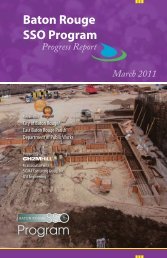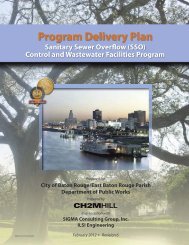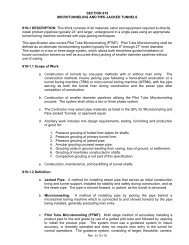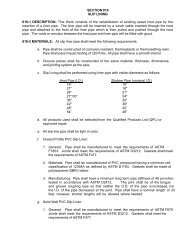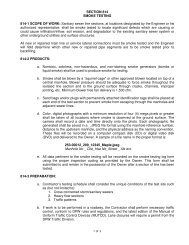Contents
Construction Management Plan - Baton Rouge Department of Public ...
Construction Management Plan - Baton Rouge Department of Public ...
- No tags were found...
You also want an ePaper? Increase the reach of your titles
YUMPU automatically turns print PDFs into web optimized ePapers that Google loves.
2.1 Restricted Areas/Activities & Facility-Specific Requirements<br />
The following areas/activities are not covered and must not be entered or performed under these<br />
instructions. If any of these areas/activities must be entered or performed, contact the Regional<br />
Health and Safety Manager (Alan Cyrier: (770) 331-2829) for assistance.<br />
• Excavations<br />
• Barricaded areas (unless with prior approval<br />
from facility representative)<br />
• Areas presenting exposed energized<br />
electrical equipment (unless accompanied by<br />
qualified individual)<br />
• Areas exposed to vehicular traffic<br />
• Areas where health hazards exist above<br />
action levels (such as Asbestos, Lead)<br />
• Activities requiring respiratory protection<br />
• Activities requiring personal protective<br />
equipment that personnel have not been trained<br />
to use<br />
• Activities requiring the use of scaffolding, aerial<br />
lifts or hoisted personal platforms<br />
• Any other areas where special access<br />
requirements exist (training, medical<br />
monitoring, security, etc.)<br />
2.2 Project-Specific Hazards<br />
2.2.1 Aerial Lifts<br />
(Reference CH2M HILL SOP HSE&Q-301, Aerial Lifts)<br />
• Only authorized and trained personnel are permitted to operate aerial lifts.<br />
• Inspect aerial lifts and test lift controls prior to use.<br />
• Wear a full body harness with lanyard attached to the boom or platform, with the shortest<br />
lanyard possible to prevent being thrown out of the basket. For scissors lifts where a standard<br />
guardrail system is installed and you are working within the confines of such a system, full<br />
body harness and lanyard are not required.<br />
• Do not attach lanyard to any adjacent structures or equipment while working from an aerial lift.<br />
• Stand firmly on the floor of the platform and do not sit or climb on the railings of the platform<br />
or use planks, ladders, or other devices to increase working height.<br />
• Remain in the platform at all times and do not leave the platform to climb to adjacent<br />
structures.<br />
• Position aerial lifts on firm, level surfaces when possible, with the brakes set. Use wheel chocks<br />
on inclines. If outriggers are provided, position on solid surfaces or cribbing.<br />
• Maintain safe clearance distances between overhead power lines and any part of the aerial lift<br />
or conducting material unless the power lines have been de-energized and grounded, or where<br />
insulating barriers have been installed to prevent physical contact. Maintain at least 10 feet from<br />
overhead power lines for voltages of 50 kV or less, and 10 feet plus ½ inch for every 1 kV over<br />
50 kV.<br />
• Do not exceed the boom and basket load limits.<br />
• Do not use aerial lifts as cranes, unless specifically designed and approved by the lift<br />
manufacturer.<br />
• Do not work or stand below aerial lift operations.<br />
• Do not use aerial lifts when winds exceed 30 miles per hour.<br />
GNV310133632156.DOC/090840008 A-11



